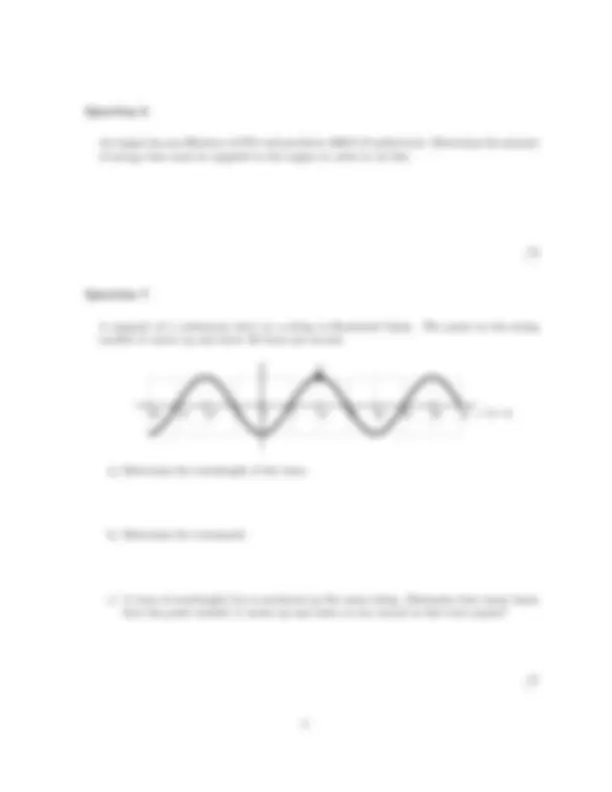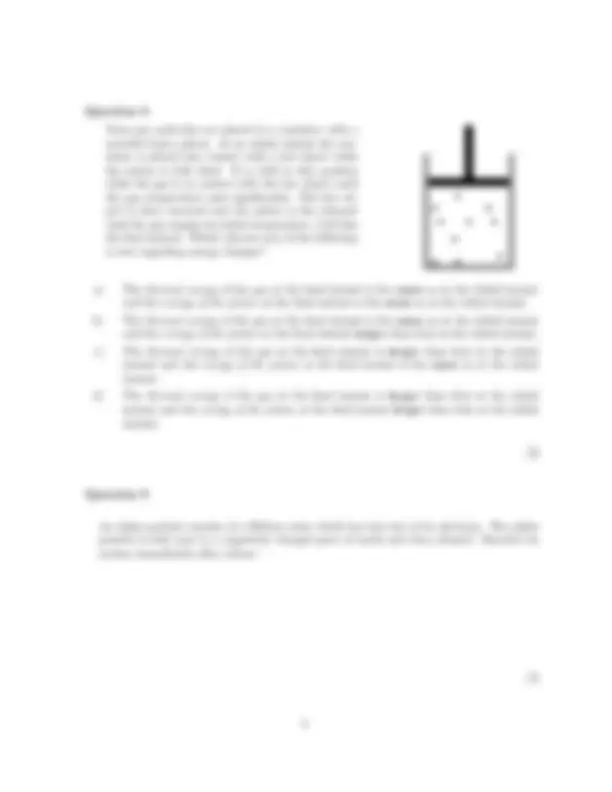





Study with the several resources on Docsity

Earn points by helping other students or get them with a premium plan


Prepare for your exams
Study with the several resources on Docsity

Earn points to download
Earn points by helping other students or get them with a premium plan
Community
Ask the community for help and clear up your study doubts
Discover the best universities in your country according to Docsity users
Free resources
Download our free guides on studying techniques, anxiety management strategies, and thesis advice from Docsity tutors
Material Type: Exam; Professor: Collins; Class: Concepts of Physics-GTSC2; Subject: Physics; University: Mesa State College; Term: Spring 2008;
Typology: Exams
1 / 6

This page cannot be seen from the preview
Don't miss anything!




Phys 100 Spring 2008
4 April 2008
speed =
distance traveled time elapsed s =
d t net force = mass × acceleration F = m × a earth’s gravitational force = mass × 9. 8 F = m × 9. 8
KE =
mass × (speed)^2 F =
m × v^2 gravPE = mass × 9. 8 × height F = m × 9. 8 × h
power =
energy gain time elapsed
t efficiency = work done heat in
wave speed = wavelength × frequency s = λ × f
Two vehicles, an SUV and a subcompact car, move in a straight line. The mass of the subcompact car is 1000 kg and it moves with speed 20 m/s. The mass of the SUV is 4000 kg and it moves with speed 10 m/s. Which of the following (choose one) is true?
a) The kinetic energy of the SUV is the same as that of the subcompact car. b) The kinetic energy of the SUV is 2 times that of the subcompact car. c) The kinetic energy of the SUV is 1/2 of that of the subcompact car. d) The kinetic energy of the SUV is 1/4 of that of the subcompact car.
A pendulum (an small ball that swings from a string) is released from rest at the indicated position. The string en- counters a “peg” in its path. Which (choose one) indicates the highest point that the pendulum ball reaches after the string strikes the peg?
Release Highest point
(a)
(b)
(c)
(d)
Question 3^ /
A cart of mass 2 kg is free to slide along the illus- trated surface. At the bottom of the ramp the cart has kinetic energy of 500 J. The height of the top of the ramp above the base is 50 m. The cart ascends the ramp.
a) Describe how the kinetic energy changes (i.e. increases, decreases or stays the same) as the cart ascends the ramp. If the kinetic energy does change, describe what it is converted to.
b) Determine whether the cart will reach the top of the ramp.
/
An engine has an efficiency of 25% and produces 1000 J of useful work. Determine the amount of energy that must be supplied to the engine in order to do this.
/
A segment of a continuous wave on a string is illustrated below. The point on the string marked A moves up and down 20 times per second.
-4 -3 -2 -1 0 1 2 3 4 5 6 7
0
1
-20 -15 -10 -5 0 5 10 15 20 25 30 35 x^ in m
A b
a) Determine the wavelength of the wave.
b) Determine the wavespeed.
c) A wave of wavelength 5 m is produced on the same string. Determine how many times does the point marked A moves up and down in one second as this wave passes?
/
Neon gas molecules are placed in a container with a movable heavy piston. At an initial instant the con- tainer is placed into contact with a hot object while the piston is held fixed. It is held in this position while the gas is in contact with the hot object until the gas temperature rises significantly. The hot ob- ject is then removed and the piston is the released until the gas regains its initial temperature. Call this the final instant. Which (choose one) of the following is true regarding energy changes?
b
b
b
(^) b
b b
b b
b b
a) The thermal energy of the gas at the final instant is the same as at the initial instant and the energy of the piston at the final instant is the same as at the initial instant. b) The thermal energy of the gas at the final instant is the same as at the initial instant and the energy of the piston at the final instant larger than that at the initial instant. c) The thermal energy of the gas at the final instant is larger than that at the initial instant and the energy of the piston at the final instant is the same as at the initial instant. d) The thermal energy of the gas at the final instant is larger than that at the initial instant and the energy of the piston at the final instant larger than that at the initial instant.
/
An alpha particle consists of a Helium atom which has lost two of its electrons. The alpha particle is held near to a negatively charged piece of metal and then released. Describe its motion immediately after release.
/